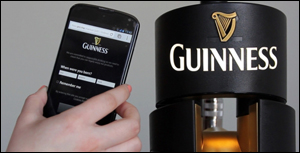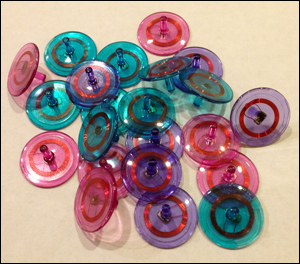Aug 15, 2013The following are news announcements made during the past week by the following organizations: Proxama; Trimble; Zebra Technologies; Skytron; WaveMark; CastNET; and Sensorstream.
Guinness Dispenses Stout, NFC Mobile Marketing Right from the Tap
Guinness, a popular stout marketed by Diageo, is launching a new mobile-marketing program that leverages Near Field Communication (NFC) RFID technology provided by Proxama, an NFC mobile-commerce firm with offices in the United Kingdom and New York. According to Proxama, Guinness is using its TapPoint platform, an online campaign- and voucher-management system that enables brands, retailers, agencies and media owners to create NFC marketing campaigns. TapPoint can be utilized to create a variety of campaigns, such as vouchers, loyalty cards, video and audio downloads, product information (price comparisons, for instance), games, application downloads and more. The system includes wizard-based tools that companies can employ to create URL-based campaigns, as well as advanced tools for creating more complex campaigns, the ability to assign locations to NFC tags, campaign reporting software for analysis purposes, and integration capability with third-party campaign-management systems. According to Proxama, Guinness has fitted Smartrac's passive 13.56 MHz tags containing NXP Semiconductors' NTAG203 chip into more than 11,000 new founts (a type of beer tap) for dispensing the stout at outlets in Great Britain, with 53,000 single and dual founts expected to be installed by 2015. The beer company is using a mix of 29-millimeter (1.14-inch) and 38-millimeter (1.5-inch) tags that have been supplied and programmed by Dot Origin, located just behind the harp symbol on the founts. In Ireland, 2,800 outlets to date have received the new founts, with a further 12,155 slated to do so by 2015. Initial trials will run until the end of August at 20 Stonegate Pub outlets in the United Kingdom, where patrons can interact with the NFC technology by downloading the Guinness mobile app onto their smartphone and then tapping the phone against the harp symbol to find out if they have won a complimentary pint. According to Proxama, the Stonegate Pub trial is designed to test the technology, as well as consumer behavior and reaction to NFC. "Guinness is committed to using innovation to develop new marketing tools that will excite consumers and drive valuable sales for our customers," said Nick Britton, Diageo's marketing manager for Guinness Western Europe, in a prepared statement. "The new NFC activity is a prime example of this, and shows how we have implemented the latest technology in our founts, to keep our audience engaged whilst rewarding them with offers, vouchers competitions and content." Miles Quitmann, Proxama's managing director, added in the statement that "deploying the technology to the whole Guinness estate demonstrates how influential Diageo sees NFC in supporting mobile marketing and consumer engagement. Brands get very few opportunities to have meaningful one-to-one interactions with their consumers; NFC is changing this by allowing brands to interact with consumers that have proactively chosen to engage with them."
Trimble Intros Micro-LTE UHF RFID Module
Trimble has announced the addition of the Micro-LTE to its ThingMagic Mercury 6e series of embedded ultrahigh-frequency (UHF) RFID modules. The Micro-LTE joins the ThingMagic Micro, released in November 2012 (see ThingMagic Releases New Tiny Reader Module). Both devices are ultra-small modules designed for products, such as handheld and fixed readers and printers, offering smaller footprints. Both the M6e-Micro and Micro-LTE measure 46 millimeters (1.8 inches) in length and 26 millimeters (1 inch) in width. They each have two antenna ports and support EPCglobal's Gen 2 and ISO 18000-6C protocols. According to Trimble, however, the Micro is designed for applications involving medium to large tag populations, whereas the Micro-LTE is optimized for smaller tag populations, making it suitable for tolling, vehicle-management, race-timing and access-control applications. The Micro-LTE also has a lower power consumption, a feature that the company says works well with battery-operated applications, and a wide RF output range (-5 dBm to +30 dBm)—which, according to Trimble, is a key requirement for RFID-enabled printers, tag-commissioning stations and point-of-sale (POS) readers. Like the ThingMagic Micro, the Micro-LTE is designed for high-volume production environments and supports both traditional board-to-board mounting and solder-down surface mounting, thereby reducing component and assembly costs for equipment manufacturers. Additional features of the Micro-LTE include UART and USB 2.0 control/data interfaces, two 3.3V bidirectional ports configurable as input (sensor) or output (indicator) ports, and support for North America, the European Union (EU) and the People's Republic of China (PRC) regions, with a single stock-keeping unit (SKU). Zebra Technologies recently announced its ZD500R UHF desktop printer, which employs the Micro-LTE RFID module. The ZD500R, expected to be commercially available in the 2013-2014 timeframe, is suitable for space-constrained retail and health-care environments, the company reports, and is Zebra's smallest and lowest-cost UHF RFID printer to date. "Increasingly, we've seen RFID applications expand beyond warehousing and manufacturing into retail and health-care environments that demand smaller, lighter and more efficient devices," said Michael Fein, Zebra Technologies' senior product manager, in a prepared statement. "ThingMagic RFID modules and advanced firmware features help us deliver small, low-cost, and feature-complete products that are easy for users to operate and system integrators to deploy."
Skytron Unveils RFID-enabled Smart Cabinets for Tracking Health-care Products
Skytron has announced a new addition to its portfolio of RFID-enabled health-care products: SkyTrac, a line of RFID-enabled smart cabinets designed to help health-care facilities automatically track such consumable items as sutures, stents and implants used for patient care. The cabinets eliminate the need to manually track inventory, the company explains, and can issue alerts for recalled or expired products. This latest RFID technology is designed to reduce the loss and misplacement of supplies, Skytron reports, while improving efficiency and patient safety. The smart cabinets feature RFID technology from WaveMark, which includes 13.56 MHz RFID readers compliant with the ISO 15693 standard, as well as reader antennas. There are several designs and sizes available, including a five-shelf cabinet that measures 80 inches high (with wheels), 44.5 inches wide and 21 inches deep. The cabinet, suitable for boxed products stored within a procedure or store room, features a locking-door option for storing high-value items. The standing products bin, measuring 40.5 inches high (with wheels), 44.5 inches wide and 21 inches deep, is intended for long-standing products, such as ablation catheters or AAA grafts. There is also a smart cabinet for guiding catheters and other hanging products, a tabletop smart cabinet for small assets, and a mobile cart with four shelves that can be easily transported from a storage room to a procedure room. According to the company, the RFID technology not only improves safety and efficiency, but also helps hospitals avoid under- and overstocking products, as well as capture product-use data for patient-billing purposes. "Skytron is already known to have the lowest total cost of ownership on our equipment such as our surgical lighting, tables and booms," said David Mehney, Skytron's CEO, in a prepared statement. "We are excited to help hospitals reduce expense further by offering a technology solution that will provide savings straight to the bottom line while improving safety and efficiency." WaveMark's technology, also featured in the company's own line of smart cabinets (see Ann Arbor VA Hospital Tracks Lab Supplies Via RFID), has helped save time and money, Skytron reports. According to SkyTron, WaveMark has indicated that individual hospital departments equipped with its technology have saved more than 500 staff hours, reduced on-hand inventory by as much as 30 percent, and experienced annual savings of $350,000 to $750,000.
CastNET Announces NFC-enabled Digital-Signage Solution
CastNET has announced a new solution, known as CastNET with MobileHere, that integrates Near Field Communication (NFC) technology with its digital-signage software. The technology combines CastNET's digital-signage content-management software with NFC technology so that digital-signage screens can easily share information with mobile devices via NFC. By placing an NFC-enabled smartphone or mobile device against a CastNET with MobileHere digital sign, the company explains, a viewer can instantly download information or be directed to rich media content on his or her device. CastNET's content-management software provides message templates that allow users to add rich media links to the content featured on the side of the CastNET digital sign; when a customer or viewer taps his or her NFC-enabled smartphone on the MobileHere tag featured on the digital sign, that individual is directed to the corresponding content. As information changes on the digital sign, the NFC tag can be refreshed automatically with new content. The benefits, according to CastNET, include enabling customers and visitors to take the information featured on a digital sign with them, and allowing companies to expand the amount of information they can offer, by directing visitors and customers to Web sites, videos or mobile app stores, as well as by offering instant downloads of maps, menus, coupons and other types of information. An equally important benefit provided by CastNET with MobileHere, the company notes, is the increased collection of data regarding the effectiveness of any digital-signage deployment. CastNET with MobileHere automatically tracks each viewer's engagements to a database that supplies reports indicating which particular displays and messages are attracting attention. "NFC is the next big thing in the digital signage industry," said Lance Hutchinson, CastNET's VP, in a prepared statement. "CastNET with MobileHere is a product that not only improves the experience for customers and guests in a store or venue, but also provides immediate and accurate reporting on the effectiveness of how and where digital signage is being used. A lot of development time was invested into making sure the CastNET user experience for updating NFC 'to go' content works seamlessly with CastNET's already easy-to-use software workflow."
Sensorstream Launches NFC-enabled Golf-Ball Marker
Boston-based startup Sensorstream has announced the Birdie, a translucent golf-ball marker embedded with a Near Field Communication (NFC) microchip micro-soldered to a coil antenna, capable of wirelessly storing, receiving and transmitting digital data. The NFC-enabled golf-ball marker is designed to let golfers easily share their business cards, make cashless payments at the golf course and use Twitter or other social-media sites while playing a round of golf. The Birdie utilizes NXP Semiconductors' NTAG203 chip—which, along with the special coil antenna, has been encapsulated in a DuPont plastic polymer that makes the Birdie waterproof and durable, yet still ensures NFC wireless functionality. The marker can be programmed using Sensorstream's free Android application directly from an HTC, Samsung or Sony NFC-enabled phone. Possible uses, Sensorstream reports, include enabling golfers to download their contact information to the Birdie in order to create digital business cards. According to Sensorstream, businesses sponsoring golf tournaments could hand out Birdies featuring company information, coupons and so forth, while an RFID-enabled ignition system on a golf cart could be linked with the Birdie, enabling it to be used to start the cart. "Birdie is our entry into the growing active use and wearable consumer electronics market. There are literally millions of golfers out there and they all need a golf ball marker," said Tom Rapko, Sensorstream's founder, in a prepared statement. "I also think Birdie is a great tool to help Fortune 500 companies market their brands more effectively, because the cool thing about a golf ball marker is that most golfers keep their markers with them not just for one or two rounds, but typically for the entire season. From a utility standpoint, that's great; from a marketing standpoint, that's tough to beat." Sensorstream is actively seeking partnerships with retail distributors to roll out the Birdie across the country, the company adds, and is presently pursuing licensing agreements with several major golf manufacturers. Available now, the Birdies retail for $5 apiece, with volume order pricing available, as well as custom logo printing and unique datasets for corporate clients.



